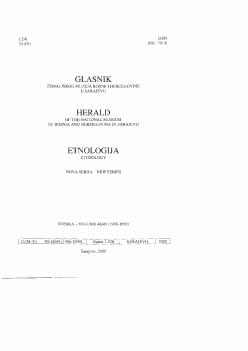Život u centru Kamenjak u Puli
Life in the Refugee Center Kamenjak in Pula
Author(s): Marica Popić-FilipovićSubject(s): Anthropology
Published by: Zemaljski muzej Bosne i Hercegovine
Summary/Abstract: In 1992, the war refugees from Bosnia and Herzegovina were in the Republic of Croatia placed into deserted military barracks of the former Yugoslav National Army. The premises were therein severely damaged after the army had retreated, thus significantly reducing the quality of living conditions. In Pula military barracks, many families (4 -6 families or 20 -2S persons) resided together in huge military dormitories, without possibility of grouping them based on age, sex or their medical conditions. Food and preventive medical care were organized within the refugee center, whereas the administrative work was done by employees of the Social Work Center of the City of Pula. Majority of refugees residing in the center belonged to rural population. Around the beginning of 1993, another military barraeks was prepared for accommodation of refugees (by the Swiss Government). Thus the refugees that moved into this new facility were provided with much better living conditions (heating, better food). Taking care about youth and children was organized and performed by volunteers -young people from all over the world, employed by the UNHCR, who used to organize sport and cultural activities for children, youth and adults. In the further text the paper discusses the reasons of high fluctuation rate among refugees leaving to other European or overseas countries in the course of 1993 and 1994. In the summer of 1994, however, a number of refugees returns to their country, to the area of central Bosnia. In refugee centers, refugees tried to organize their life in the way it was organized at home. This included arranging of their furniture in the way they used to do it at ho me. wearing their traditional clothes, preserving the rhythm of their everyday activities; mutual communication and contacts with their relatives or neighbors; adjusting the diet to their own eating habits, fulfilling their religious and social needs and obligations, etc. The complex conditions of living in the refugee center influenced the behavior of refugees that tried, while residing temporarily in the center, to preserve their identity and customs, but at the same to adjust to living in the new community. Certain number of refugees manifested a wish for complete integration in the new community. For large number of them, the only solution in the situation they were in, was to move to distant countries where they would start a completely new life, full of uncertainty. However. the greatest number of refugee families eventually decided to return to their country and wait for the opportunity to return to their households.
Journal: Glasnik Zemaljskog muzeja Bosne i Hercegovine u Sarajevu: Etnologija
- Issue Year: 1996
- Issue No: 48-49
- Page Range: 257-269
- Page Count: 13
- Language: Bosnian

